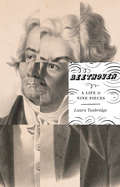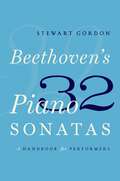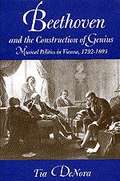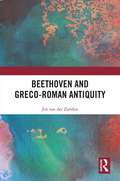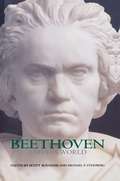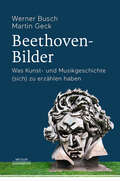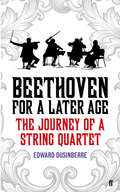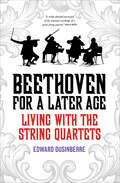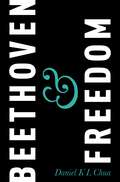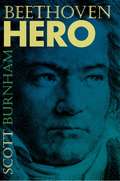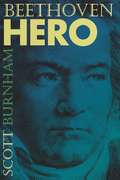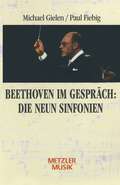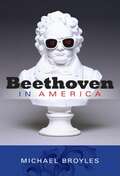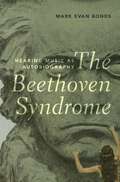- Table View
- List View
Beethoven: A Life in Nine Pieces
by Laura TunbridgeA major new biography published for the 250th anniversary of Beethoven’s birth, offering a fresh, human portrayal The iconic image of Beethoven is of him as a lone genius: hair wild, fists clenched, and brow furrowed. Beethoven may well have shaped the music of the future, but he was also a product of his time, influenced by the people, politics, and culture around him. Oxford scholar Laura Tunbridge offers an alternative history of Beethoven’s career, placing his music in contexts that shed light on why particular pieces are valued more than others, and what this tells us about his larger-than-life reputation. Each chapter focuses on a period of his life, a piece of music, and a revealing theme, from family to friends, from heroism to liberty. We discover, along the way, Beethoven’s unusual marketing strategies, his ambitious concert programming, and how specific performers and instruments influenced his works. This book offers new ways to understand Beethoven and why his music continues to be valued today.
Beethoven: A Life in Nine Pieces
by Laura Tunbridge2020 marks 250 years since Beethoven's birthLudwig van Beethoven: to some, simply the greatest ever composer of Western classical music. Yet his life remains shrouded in myths, and the image persists of him as an eccentric genius shaking his fist at heaven.Beethoven by Oxford professor Laura Tunbridge cuts through the noise in a refreshing way. Each chapter focuses on a period of his life, a piece of music and a revealing theme, from family to friends, from heroism to liberty. It's a winning combination of rich biographical detail, insight into the music and surprising new angles, all of which can transform how you listen to his works. We discover, for example, Beethoven's oddly modern talent for self-promotion, how he was influenced by factors from European wars to instrument building, and how he was heard by contemporaries.This tour de force - published for the 250th anniversary of Beethoven's birth - provides a fresh overview and a wealth of material that has never been revealed to the wider public before. It's a compelling, human portrayal of Beethoven and a fascinating journey into one of the world's most amazing creative minds.'We are doubly blessed that Beethoven should have led such an extraordinary life. Laura has combined the two - the genius of his music and the richness of his experiences - to shine a revealing light on our greatest composer' John Humphrys'Tunbridge has come up with the seemingly impossible: a new way of approaching Beethoven's life and music. . . profoundly original and hugely readable' John Suchet, author Beethoven: The Man Revealed'This well researched and accessible book is a must read for all who seek to know more about the flesh and blood tangible Beethoven.'John Clubbe, author of Beethoven: The Relentless Revolutionary'This book is really wonderful! ... However many books on Beethoven you own, find the space for one more. This one'Stephen Hough, pianist, composer, writer'In a year when everyone's looking for a new take on Beethoven, Laura Tunbridge has found nine. ...Fresh and engaging'Norman Lebrecht, author of Genius and Anxiety'Remarkable . . . she captures the essence of his genius and character. I'll always want to keep it in easy reach'Julia Boyd, author of Travellers in the third Reich
Beethoven 1806 (AMS Studies in Music)
by Mark FerragutoBetween early 1806 and early 1807, Ludwig van Beethoven completed a remarkable series of instrumental works. But critics have struggled to reconcile the music of this banner year with Beethoven's "heroic style," the paradigm through which his middle-period works have typically been understood. Drawing on theories of mediation and a wealth of primary sources, Beethoven 1806 explores the specific contexts in which the music of this year was conceived, composed, and heard. As author Mark Ferraguto argues, understanding this music depends on appreciating the relationships that it both creates and reflects. Not only did Beethoven depend on patrons, performers, publishers, critics, and audiences to earn a living, but he also tailored his compositions to suit particular sensibilities, proclivities, and technologies.
Beethoven 1806 (AMS Studies in Music)
by Mark FerragutoBetween early 1806 and early 1807, Ludwig van Beethoven completed a remarkable series of instrumental works. But critics have struggled to reconcile the music of this banner year with Beethoven's "heroic style," the paradigm through which his middle-period works have typically been understood. Drawing on theories of mediation and a wealth of primary sources, Beethoven 1806 explores the specific contexts in which the music of this year was conceived, composed, and heard. As author Mark Ferraguto argues, understanding this music depends on appreciating the relationships that it both creates and reflects. Not only did Beethoven depend on patrons, performers, publishers, critics, and audiences to earn a living, but he also tailored his compositions to suit particular sensibilities, proclivities, and technologies.
BEETHOVEN 32 PIANO SONATAS C: A Handbook for Performers
by Stewart GordonThe thirty-two Piano Sonatas of Ludwig van Beethoven form one of the most important segments of piano literature. In this accessible, compact, and comprehensive guidebook, renowned performer and pedagogue Stewart Gordon presents the pianist with historical insights and practical instructional tools for interpreting the pieces. In the opening chapters of Beethoven's 32 Piano Sonatas, Gordon illuminates the essential historical context behind common performance problems, discussing Beethoven's own pianos and how they relate to compositional style and demands in the pieces, and addressing textual issues, performance practices, and nuances of the composer's manuscript inscriptions. In outlining patterns of structure, sonority, keyboard technique, and emotional meaning evident across Beethoven's compositional development, Gordon provides important background and technical information key to understanding his works in context. Part II of the book presents each sonata in an outline-chart format, giving the student and teacher ready access to essential information, interpretive choices, and technical challenges in the individual works, measure by measure, all in one handy reference source. In consideration of the broad diversity of today's Beethoven interpreters, Gordon avoids one-size-fits-all solutions or giving undue weight to his own tastes and preferences. Instead, he puts the choices in the hands of the performers, enabling them to create their own personal relationship with the music and a more powerful performance.
Beethoven And The Construction Of Genius: Musical Politics In Vienna, 1792-1803 (PDF)
by Tia DeNoraIn this provocative account Tia DeNora reconceptualizes the notion of genius by placing the life and career of Ludwig van Beethoven in its social context. She explores the changing musical world of late eighteenth-century Vienna and follows the activities of the small circle of aristocratic patrons who paved the way for the composer's success. DeNora reconstructs the development of Beethoven's reputation as she recreates Vienna's robust musical scene through contemporary accounts, letters, magazines, and myths-a colorful picture of changing times. She explores the ways Beethoven was seen by his contemporaries and the image crafted by his supporters. Comparing Beethoven to contemporary rivals now largely forgotten, DeNora reveals a figure musically innovative and complex, as well as a keen self-promoter who adroitly managed his own celebrity. DeNora contends that the recognition Beethoven received was as much a social achievement as it was the result of his personal gifts. In contemplating the political and social implications of culture, DeNora casts many aspects of Beethoven's biography in a new and different light, enriching our understanding of his success as a performer and composer.
Beethoven and Greco-Roman Antiquity
by Jos van ZandenLudwig van Beethoven had a life beyond music. He considered it his duty to spend leisure-time improving his Bildung (sophistication). To this end he familiarised himself with tangible manifestations of Greco-Roman antiquity, for he perceived these cultures and their representatives as examples of intellectual, moral, and artistic perfection. He consumed such writers as Homer, Plutarch, Horace, Tacitus, Euripides, and Greek poets. These texts were morally uplifting for him, and advantageous for building character. They now hold a key to Beethoven’s ideal of a steadfast, austere, and Stoic outlook, necessary for a ‘great man’ to carry out his duties. Jos van der Zanden demonstrates that Beethoven’s engagement with Greco-Roman culture was deep and ongoing, and that it ventured beyond the non-committal. Drawing on a comprehensive investigation of primary sources (letters, conversation books, diaries, recollections of contemporaries) he examines what Beethoven knew of such topics like history, art, politics, and philosophy of antiquity. The book presents new information on the composer’s republicanism, his familiarity with the works of Plato, his admiration of the elderly Brutus, his plan to utilize ‘unresolved dissonances’ in an unknown piece of music, and his decision to subscribe to a book about ancient Greek poetry. A hitherto unknown vocal piece based on lines by Euripides is revealed. The study concludes with a comprehensive survey of all compositions and sketches by Beethoven based on Greco-Roman subjects.
Beethoven and Greco-Roman Antiquity
by Jos van ZandenLudwig van Beethoven had a life beyond music. He considered it his duty to spend leisure-time improving his Bildung (sophistication). To this end he familiarised himself with tangible manifestations of Greco-Roman antiquity, for he perceived these cultures and their representatives as examples of intellectual, moral, and artistic perfection. He consumed such writers as Homer, Plutarch, Horace, Tacitus, Euripides, and Greek poets. These texts were morally uplifting for him, and advantageous for building character. They now hold a key to Beethoven’s ideal of a steadfast, austere, and Stoic outlook, necessary for a ‘great man’ to carry out his duties. Jos van der Zanden demonstrates that Beethoven’s engagement with Greco-Roman culture was deep and ongoing, and that it ventured beyond the non-committal. Drawing on a comprehensive investigation of primary sources (letters, conversation books, diaries, recollections of contemporaries) he examines what Beethoven knew of such topics like history, art, politics, and philosophy of antiquity. The book presents new information on the composer’s republicanism, his familiarity with the works of Plato, his admiration of the elderly Brutus, his plan to utilize ‘unresolved dissonances’ in an unknown piece of music, and his decision to subscribe to a book about ancient Greek poetry. A hitherto unknown vocal piece based on lines by Euripides is revealed. The study concludes with a comprehensive survey of all compositions and sketches by Beethoven based on Greco-Roman subjects.
Beethoven and His World (The Bard Music Festival #48)
by Scott Burnham Michael P. SteinbergFew composers even begin to approach Beethoven's pervasive presence in modern Western culture, from the concert hall to the comic strip. Edited by a cultural historian and a music theorist, Beethoven and His World gathers eminent scholars from several disciplines who collectively speak to the range of Beethoven's importance and of our perennial fascination with him. The contributors address Beethoven's musical works and their cultural contexts. Reinhold Brinkmann explores the post-revolutionary context of Beethoven's "Eroica" Symphony, while Lewis Lockwood establishes a typology of heroism in works like Fidelio. Elaine Sisman, Nicholas Marston, and Glenn Stanley discuss issues of temporality, memory, and voice in works at the threshold of Beethoven's late style, such as An die Ferne Geliebte, the Cello Sonata op. 102, no. 1, and the somewhat later Piano Sonata op. 109. Peering behind the scenes into Beethoven's workshop, Tilman Skowroneck explains how the young Beethoven chose his pianos, and William Kinderman shows Beethoven in the process of sketching and revising his compositions. The volume concludes with four essays engaging the broader question of reception of Beethoven's impact on his world and ours. Christopher Gibbs' study of Beethoven's funeral and its aftermath features documentary material appearing in English for the first time; art historian Alessandra Comini offers an illustrated discussion of Beethoven's ubiquitous and iconic frown; Sanna Pederson takes up the theme of masculinity in critical representations of Beethoven; and Leon Botstein examines the aesthetics and politics of hearing extramusical narratives and plots in Beethoven's music. Bringing together varied and fresh approaches to the West's most celebrated composer, this collection of essays provides music lovers with an enriched understanding of Beethoven--as man, musician, and phenomenon.
Beethoven-Bilder: Was Kunst- und Musikgeschichte (sich) zu erzählen haben
by Werner Busch Martin GeckBeethoven-Bildnisse gibt es seit über 200 Jahren, und jenseits des omnipräsenten Titanenhauptes gibt es eine Vielfalt von Gestaltungen in gezeichneter, gemalter und plastischer Form, die viel über ihre jeweilige Zeit und über unsere Zugänge zu Beethovens Musik zu erkennen geben. Eine originelle Perspektive auf 200 Jahre Kulturgeschichte eröffnet dieses Gespräch zwischen einem Musik- und einem Kunsthistoriker beim Betrachten diverser Beethoven-Bilder und -Denkmäler. Das reicht vom Klassizismus der Goethezeit bis zum Dekonstruktivismus der Gegenwart, von Joseph Stieler bis Markus Lüpertz, von Napoleon Bonaparte bis Wilhelm Furtwängler und Mauricio Kagel. Ein unterhaltsames und erhellendes Gespräch zweier ausgewiesener Vertreter ihres Fachs.
Beethoven for a Later Age: The Journey of a String Quartet
by Edward Dusinberre'They are not for you but for a later age!' Ludwig van Beethoven, on the Opus 59 quartets.Tackling the Beethoven quartets is a rite of passage that has shaped the Takács Quartet's work together for over forty years. Using the history of the composition and first performances of the quartets as the backbone to his story, Edward Dusinberre, first violinist of the Takács since 1993 - recounts the life of the Quartet from its inception in Hungary, through emigration to the US and its present-day life as one of the world's renowned string quartets. He also describes what it was like for him, as a young man fresh out of the Juilliard School, to join the Quartet as its first non-Hungarian member - an exhilarating challenge. Beethoven for a Later Age takes the reader inside the life of a quartet, vividly showing how four people enjoy making music together over a long period of time. The key, the author argues, is in balancing continuity with change and experimentation - a theme that also lies at the heart of Beethoven's remarkable compositions.
Beethoven for a Later Age: Living with the String Quartets
by Edward DusinberreBeethoven’s sixteen string quartets are some of the most extraordinary and challenging pieces of music ever written. Originally composed and performed between 1798 and 1826, they have inspired artists of all kinds—not only musicians—and have been subject to endless reinterpretation. But what is it like to personally take up the challenge of these compositions, not only as a musician, but as a member of a quartet, where each player has ideas about style and expression? To answer this question, Edward Dusinberre, first violinist of the renowned Takács Quartet, offers a rare peek inside the workings of his ensemble, while providing an insightful history of the compositions and their performance. Founded in Hungary in 1975 and now based in Boulder, Colorado, the Takács is one of the world’s preeminent string quartets, and performances of Beethoven have been at the center of their work together for over forty years. Using the history of both the Takács Quartet and the Beethoven quartets as a foundation, Beethoven for a Later Age provides a backstage look at the daily life of a quartet, showing the necessary creative tension between individual and group and how four people can at the same time forge a lasting artistic connection and enjoy making music together over decades. The key, Dusinberre reveals, to a quartet crafting its own sound is in balancing continuity with change and experimentation—a theme that lies at the heart of Beethoven’s remarkable compositions. In an accessible style, suitable for novices and chamber music enthusiasts alike, Dusinberre illuminates the variety and contradictions of Beethoven's quartets, which were composed against the turbulent backdrop of the Napoleonic Wars and their aftermath, and he brings the technical aspects of the music to life. Beethoven for a Later Age vividly shows that creative engagement with Beethoven’s radical and brilliant quartets continues to be as stimulating now as it was for its first performers and audiences. Musicians and music lovers will be intrigued by Dusinberre’s exploration of the close collaboration at the heart of any great performance.
Beethoven for a Later Age: Living with the String Quartets
by Edward DusinberreBeethoven’s sixteen string quartets are some of the most extraordinary and challenging pieces of music ever written. Originally composed and performed between 1798 and 1826, they have inspired artists of all kinds—not only musicians—and have been subject to endless reinterpretation. But what is it like to personally take up the challenge of these compositions, not only as a musician, but as a member of a quartet, where each player has ideas about style and expression? To answer this question, Edward Dusinberre, first violinist of the renowned Takács Quartet, offers a rare peek inside the workings of his ensemble, while providing an insightful history of the compositions and their performance. Founded in Hungary in 1975 and now based in Boulder, Colorado, the Takács is one of the world’s preeminent string quartets, and performances of Beethoven have been at the center of their work together for over forty years. Using the history of both the Takács Quartet and the Beethoven quartets as a foundation, Beethoven for a Later Age provides a backstage look at the daily life of a quartet, showing the necessary creative tension between individual and group and how four people can at the same time forge a lasting artistic connection and enjoy making music together over decades. The key, Dusinberre reveals, to a quartet crafting its own sound is in balancing continuity with change and experimentation—a theme that lies at the heart of Beethoven’s remarkable compositions. In an accessible style, suitable for novices and chamber music enthusiasts alike, Dusinberre illuminates the variety and contradictions of Beethoven's quartets, which were composed against the turbulent backdrop of the Napoleonic Wars and their aftermath, and he brings the technical aspects of the music to life. Beethoven for a Later Age vividly shows that creative engagement with Beethoven’s radical and brilliant quartets continues to be as stimulating now as it was for its first performers and audiences. Musicians and music lovers will be intrigued by Dusinberre’s exploration of the close collaboration at the heart of any great performance.
Beethoven for a Later Age: Living with the String Quartets
by Edward DusinberreBeethoven’s sixteen string quartets are some of the most extraordinary and challenging pieces of music ever written. Originally composed and performed between 1798 and 1826, they have inspired artists of all kinds—not only musicians—and have been subject to endless reinterpretation. But what is it like to personally take up the challenge of these compositions, not only as a musician, but as a member of a quartet, where each player has ideas about style and expression? To answer this question, Edward Dusinberre, first violinist of the renowned Takács Quartet, offers a rare peek inside the workings of his ensemble, while providing an insightful history of the compositions and their performance. Founded in Hungary in 1975 and now based in Boulder, Colorado, the Takács is one of the world’s preeminent string quartets, and performances of Beethoven have been at the center of their work together for over forty years. Using the history of both the Takács Quartet and the Beethoven quartets as a foundation, Beethoven for a Later Age provides a backstage look at the daily life of a quartet, showing the necessary creative tension between individual and group and how four people can at the same time forge a lasting artistic connection and enjoy making music together over decades. The key, Dusinberre reveals, to a quartet crafting its own sound is in balancing continuity with change and experimentation—a theme that lies at the heart of Beethoven’s remarkable compositions. In an accessible style, suitable for novices and chamber music enthusiasts alike, Dusinberre illuminates the variety and contradictions of Beethoven's quartets, which were composed against the turbulent backdrop of the Napoleonic Wars and their aftermath, and he brings the technical aspects of the music to life. Beethoven for a Later Age vividly shows that creative engagement with Beethoven’s radical and brilliant quartets continues to be as stimulating now as it was for its first performers and audiences. Musicians and music lovers will be intrigued by Dusinberre’s exploration of the close collaboration at the heart of any great performance.
Beethoven for a Later Age: Living with the String Quartets
by Edward DusinberreBeethoven’s sixteen string quartets are some of the most extraordinary and challenging pieces of music ever written. Originally composed and performed between 1798 and 1826, they have inspired artists of all kinds—not only musicians—and have been subject to endless reinterpretation. But what is it like to personally take up the challenge of these compositions, not only as a musician, but as a member of a quartet, where each player has ideas about style and expression? To answer this question, Edward Dusinberre, first violinist of the renowned Takács Quartet, offers a rare peek inside the workings of his ensemble, while providing an insightful history of the compositions and their performance. Founded in Hungary in 1975 and now based in Boulder, Colorado, the Takács is one of the world’s preeminent string quartets, and performances of Beethoven have been at the center of their work together for over forty years. Using the history of both the Takács Quartet and the Beethoven quartets as a foundation, Beethoven for a Later Age provides a backstage look at the daily life of a quartet, showing the necessary creative tension between individual and group and how four people can at the same time forge a lasting artistic connection and enjoy making music together over decades. The key, Dusinberre reveals, to a quartet crafting its own sound is in balancing continuity with change and experimentation—a theme that lies at the heart of Beethoven’s remarkable compositions. In an accessible style, suitable for novices and chamber music enthusiasts alike, Dusinberre illuminates the variety and contradictions of Beethoven's quartets, which were composed against the turbulent backdrop of the Napoleonic Wars and their aftermath, and he brings the technical aspects of the music to life. Beethoven for a Later Age vividly shows that creative engagement with Beethoven’s radical and brilliant quartets continues to be as stimulating now as it was for its first performers and audiences. Musicians and music lovers will be intrigued by Dusinberre’s exploration of the close collaboration at the heart of any great performance.
Beethoven for a Later Age: Living with the String Quartets
by Edward DusinberreBeethoven’s sixteen string quartets are some of the most extraordinary and challenging pieces of music ever written. Originally composed and performed between 1798 and 1826, they have inspired artists of all kinds—not only musicians—and have been subject to endless reinterpretation. But what is it like to personally take up the challenge of these compositions, not only as a musician, but as a member of a quartet, where each player has ideas about style and expression? To answer this question, Edward Dusinberre, first violinist of the renowned Takács Quartet, offers a rare peek inside the workings of his ensemble, while providing an insightful history of the compositions and their performance. Founded in Hungary in 1975 and now based in Boulder, Colorado, the Takács is one of the world’s preeminent string quartets, and performances of Beethoven have been at the center of their work together for over forty years. Using the history of both the Takács Quartet and the Beethoven quartets as a foundation, Beethoven for a Later Age provides a backstage look at the daily life of a quartet, showing the necessary creative tension between individual and group and how four people can at the same time forge a lasting artistic connection and enjoy making music together over decades. The key, Dusinberre reveals, to a quartet crafting its own sound is in balancing continuity with change and experimentation—a theme that lies at the heart of Beethoven’s remarkable compositions. In an accessible style, suitable for novices and chamber music enthusiasts alike, Dusinberre illuminates the variety and contradictions of Beethoven's quartets, which were composed against the turbulent backdrop of the Napoleonic Wars and their aftermath, and he brings the technical aspects of the music to life. Beethoven for a Later Age vividly shows that creative engagement with Beethoven’s radical and brilliant quartets continues to be as stimulating now as it was for its first performers and audiences. Musicians and music lovers will be intrigued by Dusinberre’s exploration of the close collaboration at the heart of any great performance.
Beethoven for a Later Age: Living with the String Quartets
by Edward DusinberreBeethoven’s sixteen string quartets are some of the most extraordinary and challenging pieces of music ever written. Originally composed and performed between 1798 and 1826, they have inspired artists of all kinds—not only musicians—and have been subject to endless reinterpretation. But what is it like to personally take up the challenge of these compositions, not only as a musician, but as a member of a quartet, where each player has ideas about style and expression? To answer this question, Edward Dusinberre, first violinist of the renowned Takács Quartet, offers a rare peek inside the workings of his ensemble, while providing an insightful history of the compositions and their performance. Founded in Hungary in 1975 and now based in Boulder, Colorado, the Takács is one of the world’s preeminent string quartets, and performances of Beethoven have been at the center of their work together for over forty years. Using the history of both the Takács Quartet and the Beethoven quartets as a foundation, Beethoven for a Later Age provides a backstage look at the daily life of a quartet, showing the necessary creative tension between individual and group and how four people can at the same time forge a lasting artistic connection and enjoy making music together over decades. The key, Dusinberre reveals, to a quartet crafting its own sound is in balancing continuity with change and experimentation—a theme that lies at the heart of Beethoven’s remarkable compositions. In an accessible style, suitable for novices and chamber music enthusiasts alike, Dusinberre illuminates the variety and contradictions of Beethoven's quartets, which were composed against the turbulent backdrop of the Napoleonic Wars and their aftermath, and he brings the technical aspects of the music to life. Beethoven for a Later Age vividly shows that creative engagement with Beethoven’s radical and brilliant quartets continues to be as stimulating now as it was for its first performers and audiences. Musicians and music lovers will be intrigued by Dusinberre’s exploration of the close collaboration at the heart of any great performance.
Beethoven & Freedom
by Daniel K ChuaOver the last two centuries, Beethoven's music has been synonymous with the idea of freedom, in particular a freedom embodied in the heroic figure of Prometheus. This image arises from a relatively small circle of heroic works from the composer's middle period, most notably the Eroica Symphony. However, the freedom associated with the Promethean hero has also come under considerably critique by philosophers, theologians and political theorists; its promise of autonomy easily inverts into various forms of authoritarianism, and the sovereign will it champions is not merely a liberating force but a discriminatory one. Beethoven's freedom, then, appears to be increasingly problematic; yet his music is still employed today to mark political events from the fall of the Berlin Wall to the attacks of 9/11. Even more problematic, perhaps, is the fact that this freedom has shaped the reception of Beethoven music to such an extent that we forget that there is another kind of music in his oeuvre that is not heroic, a music that opens the possibility of a freedom yet to be articulated or defined. By exploring the musical philosophy of Theodor W. Adorno through a wide range of the composer's music, Beethoven and Freedom arrives at a markedly different vision of freedom. Author Daniel KL Chua suggests that a more human and fragile concept of freedom can be found in the music that has less to do with the autonomy of the will and its stoical corollary than with questions of human relation, donation, and a yielding to radical alterity. Chua's work makes a major and controversial statement by challenging the current image of Beethoven, and by suggesting an alterior freedom that can speak ethically to the twenty-first century.
Beethoven & Freedom
by Daniel K ChuaOver the last two centuries, Beethoven's music has been synonymous with the idea of freedom, in particular a freedom embodied in the heroic figure of Prometheus. This image arises from a relatively small circle of heroic works from the composer's middle period, most notably the Eroica Symphony. However, the freedom associated with the Promethean hero has also come under considerably critique by philosophers, theologians and political theorists; its promise of autonomy easily inverts into various forms of authoritarianism, and the sovereign will it champions is not merely a liberating force but a discriminatory one. Beethoven's freedom, then, appears to be increasingly problematic; yet his music is still employed today to mark political events from the fall of the Berlin Wall to the attacks of 9/11. Even more problematic, perhaps, is the fact that this freedom has shaped the reception of Beethoven music to such an extent that we forget that there is another kind of music in his oeuvre that is not heroic, a music that opens the possibility of a freedom yet to be articulated or defined. By exploring the musical philosophy of Theodor W. Adorno through a wide range of the composer's music, Beethoven and Freedom arrives at a markedly different vision of freedom. Author Daniel KL Chua suggests that a more human and fragile concept of freedom can be found in the music that has less to do with the autonomy of the will and its stoical corollary than with questions of human relation, donation, and a yielding to radical alterity. Chua's work makes a major and controversial statement by challenging the current image of Beethoven, and by suggesting an alterior freedom that can speak ethically to the twenty-first century.
Beethoven Hero
by Scott BurnhamBringing together reception history, music analysis and criticism, the history of music theory, and the philosophy of music, Beethoven Hero explores the nature and persistence of Beethoven's heroic style. What have we come to value in this music, asks Scott Burnham, and why do generations of critics and analysts hear it in much the same way? Specifically, what is it that fosters the intensity of listener engagement with the heroic style, the often overwhelming sense of identification with its musical process? Starting with the story of heroic quest heard time and again in the first movement of the Eroica Symphony, Burnham suggests that Beethoven's music matters profoundly to its listeners because it projects an empowering sense of self, destiny, and freedom, while modeling ironic self-consciousness. In addition to thus identifying Beethoven's music as an overarching expression of values central to the age of Goethe and Hegel, the author describes and then critiques the process by which the musical values of the heroic style quickly became the controlling model of compositional logic in Western music criticism and analysis. Apart from its importance for students of Beethoven, this book will appeal to those interested in canon formation in the arts and in music as a cultural, ethical, and emotional force--and to anyone concerned with what we want from music and what music does for us.
Beethoven Hero (PDF)
by Scott BurnhamBringing together reception history, music analysis and criticism, the history of music theory, and the philosophy of music, Beethoven Hero explores the nature and persistence of Beethoven's heroic style. What have we come to value in this music, asks Scott Burnham, and why do generations of critics and analysts hear it in much the same way? Specifically, what is it that fosters the intensity of listener engagement with the heroic style, the often overwhelming sense of identification with its musical process? Starting with the story of heroic quest heard time and again in the first movement of the Eroica Symphony, Burnham suggests that Beethoven's music matters profoundly to its listeners because it projects an empowering sense of self, destiny, and freedom, while modeling ironic self-consciousness. In addition to thus identifying Beethoven's music as an overarching expression of values central to the age of Goethe and Hegel, the author describes and then critiques the process by which the musical values of the heroic style quickly became the controlling model of compositional logic in Western music criticism and analysis. Apart from its importance for students of Beethoven, this book will appeal to those interested in canon formation in the arts and in music as a cultural, ethical, and emotional force--and to anyone concerned with what we want from music and what music does for us.
Beethoven In America: (PDF)
by Michael BroylesBeethoven permeates American culture. His image appears on countless busts and coffee mugs; his music is heard in movie scores, TV soundtracks, commercials, and pop songs; he is Schroeder's god in Peanuts and Chuck Berry's freaked-out parent in "Roll over Beethoven." In this book, Michael Broyles seeks to understand the composer as he exists in the American imagination and explores how Beethoven became a cultural icon. Broyles examines Beethoven's appearance in a variety of contexts: American commercialism, the Afrocentrist and black power movements, and the modernist critique of Romanticism. He considers portrayals of Beethoven in American film and theater and the uses of his music in film scores, as well as references to Beethoven and his music in disco, country, rock, and rap. In the end, he shows that to examine Beethoven on American soil is to examine America itself.
The Beethoven Syndrome: Hearing Music as Autobiography
by Mark Evan BondsThe "Beethoven Syndrome" is the inclination of listeners to hear music as the projection of a composer's inner self. This was a radically new way of listening that emerged only after Beethoven's death. Beethoven's music was a catalyst for this change, but only in retrospect, for it was not until after his death that listeners began to hear composers in general--and not just Beethoven--in their works, particularly in their instrumental music. The Beethoven Syndrome: Hearing Music as Autobiography traces the rise, fall, and persistence of this mode of listening from the middle of the eighteenth century to the present. Prior to 1830, composers and audiences alike operated within a framework of rhetoric in which the burden of intelligibility lay squarely on the composer, whose task it was to move listeners in a calculated way. But through a confluence of musical, philosophical, social, and economic changes, the paradigm of expressive objectivity gave way to one of subjectivity in the years around 1830. The framework of rhetoric thus yielded to a framework of hermeneutics: concert-goers no longer perceived composers as orators but as oracles to be deciphered. In the wake of World War I, however, the aesthetics of "New Objectivity" marked a return not only to certain stylistic features of eighteenth-century music but to the earlier concept of expression itself. Objectivity would go on to become the cornerstone of the high modernist aesthetic that dominated the century's middle decades. Masterfully citing a broad array of source material from composers, critics, theorists, and philosophers, Mark Evan Bonds's engaging study reveals how perceptions of subjective expression have endured, leading to the present era of mixed and often conflicting paradigms of listening.
The Beethoven Syndrome: Hearing Music as Autobiography
by Mark Evan BondsThe "Beethoven Syndrome" is the inclination of listeners to hear music as the projection of a composer's inner self. This was a radically new way of listening that emerged only after Beethoven's death. Beethoven's music was a catalyst for this change, but only in retrospect, for it was not until after his death that listeners began to hear composers in general--and not just Beethoven--in their works, particularly in their instrumental music. The Beethoven Syndrome: Hearing Music as Autobiography traces the rise, fall, and persistence of this mode of listening from the middle of the eighteenth century to the present. Prior to 1830, composers and audiences alike operated within a framework of rhetoric in which the burden of intelligibility lay squarely on the composer, whose task it was to move listeners in a calculated way. But through a confluence of musical, philosophical, social, and economic changes, the paradigm of expressive objectivity gave way to one of subjectivity in the years around 1830. The framework of rhetoric thus yielded to a framework of hermeneutics: concert-goers no longer perceived composers as orators but as oracles to be deciphered. In the wake of World War I, however, the aesthetics of "New Objectivity" marked a return not only to certain stylistic features of eighteenth-century music but to the earlier concept of expression itself. Objectivity would go on to become the cornerstone of the high modernist aesthetic that dominated the century's middle decades. Masterfully citing a broad array of source material from composers, critics, theorists, and philosophers, Mark Evan Bonds's engaging study reveals how perceptions of subjective expression have endured, leading to the present era of mixed and often conflicting paradigms of listening.
